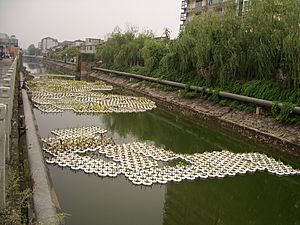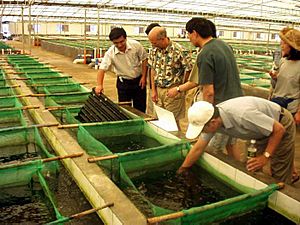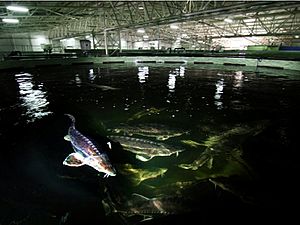Aquaculture facts for kids
Aquaculture is like farming, but for water animals and plants! It's how we raise fish, shrimp, algae, and other seafood in controlled environments. This way, we can get popular seafood like catfish, salmon, and trout. Aquaculture started a very long time ago in China, and today it provides more than 20% of all the seafood we eat.
In Canada, aquaculture is quite new, only beginning in 1879.
Contents
Types of Farmed Seafood
Aquatic Plants
Tiny water plants called microalgae (also known as phytoplankton) are the most common type of algae grown. Larger water plants, like seaweed, are also very useful for food and industry. However, because they are so big and need special conditions, they are usually gathered from the wild instead of being farmed.
Fish Farming
Farming fish is the most common type of aquaculture. It means raising fish in big tanks, fish ponds, or special pens in the ocean. Most of the time, these fish are grown for food. A place that raises young fish and then releases them into rivers or oceans for fishing or to help wild populations is called a fish hatchery.
Around the world, the most important fish species farmed are carp, salmon, tilapia, and catfish.
- Tuna Farming: In the Mediterranean Sea, young bluefin tuna are caught and slowly brought to shore. They are then kept in large pens in the ocean to grow bigger for the market. In 2009, scientists in Australia even managed to get southern bluefin tuna to have babies in tanks on land!
- Salmon Farming: Salmon are often raised in special net cages in open water with strong currents. They are fed a special mix of food to help them grow quickly. This method allows salmon to be grown all year round, leading to more harvests. Another way is called sea ranching. This is when young fish are raised in a hatchery for a short time. Then, they are released into the ocean to grow up. Once they are mature, they are caught again.
Crustacean Farming
Commercial shrimp farming started in the 1970s and grew very fast. By 2003, over 1.6 million tons of shrimp were farmed globally, worth about US$9 billion. About 75% of farmed shrimp comes from Asia, especially China and Thailand. The rest is mostly from Latin America, with Brazil being the largest producer there. Thailand is the biggest exporter of farmed shrimp.
Shrimp farming has changed a lot, from small family farms to a big global business. New technologies allow many more shrimp to be raised in a small area. The two main types of farmed shrimp are the Pacific white shrimp and the giant tiger prawn. These large-scale farms, where only one type of shrimp is grown, can sometimes get sick easily. This has caused big problems for shrimp populations in some areas.
Because of environmental concerns and disease outbreaks, people started working to make shrimp farming more eco-friendly. In 1999, governments, businesses, and environmental groups started a program to create better farming practices.
Farming freshwater prawns is similar to marine shrimp farming and faces many of the same challenges. The main type of freshwater prawn farmed is the giant river prawn.
In 2003, about 280,000 tons of freshwater prawns were produced globally. China produced the most, with 180,000 tons. India and Thailand each produced 35,000 tons. China also produced about 370,000 tons of Chinese river crab.
Mollusc Farming
Farmed shellfish include different types of oysters, mussels, and clams. These shellfish eat tiny particles from the water, so they don't need extra food from people. Because of this, farming shellfish is often seen as good for the environment.
Shellfish can be grown on beaches, on long ropes, or hanging from rafts. They are harvested by hand or by special machines. In 2017, a group in Belgium even started growing mussels on a wind farm in the North Sea as a trial!
Abalone farming began in Japan and China in the late 1950s and early 1960s. This industry has become very successful since the mid-1990s. Because too many wild abalone were caught, farmed abalone now provides most of the abalone meat we eat. Organizations like Seafood Watch and the World Wildlife Fund (WWF) help certify that farmed shellfish are raised in a sustainable way.
In 2012, a commercial "sea ranch" for abalone was set up in Flinders Bay, Western Australia. This ranch uses an artificial reef made of 5000 concrete blocks called abitats (abalone habitats). Each block can hold 400 abalone. Young abalone from a hatchery are placed on the reef. The abalone eat seaweed that grows naturally on the blocks. This project also helps other fish like dhufish and snapper grow in the bay.
Brad Adams, from the company, says their method is more like "ranching" than traditional aquaculture. He explains, "We're not aquaculture, we're ranching, because once they're in the water they look after themselves."
Other Farmed Animals
Other groups of farmed water animals include reptiles, amphibians, and various invertebrates like sea cucumbers and sea urchins. These are farmed in smaller amounts compared to fish and shrimp. For example, in China, sea cucumbers are farmed in artificial ponds that can be as large as 1000 acres.
Images for kids
See also
 In Spanish: Acuicultura para niños
In Spanish: Acuicultura para niños









